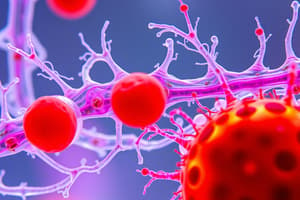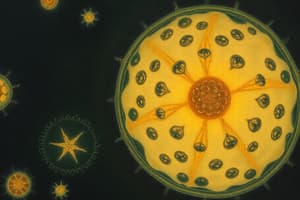Podcast
Questions and Answers
Which of the following statements accurately reflects a core tenet of the cell theory?
Which of the following statements accurately reflects a core tenet of the cell theory?
- Cells can spontaneously generate from non-living matter under specific environmental conditions.
- New cells are produced from inorganic compounds.
- Cells are the smallest unit of non-living matter.
- All living organisms are composed of one or more cells, and these cells arise from pre-existing cells. (correct)
Which cellular structure is present in both prokaryotic and eukaryotic cells, highlighting a fundamental similarity between these cell types?
Which cellular structure is present in both prokaryotic and eukaryotic cells, highlighting a fundamental similarity between these cell types?
- Nucleus
- Endoplasmic reticulum
- Ribosomes (correct)
- Golgi apparatus
What is the primary distinction between unicellular and multicellular organisms, based on the principles of the cell?
What is the primary distinction between unicellular and multicellular organisms, based on the principles of the cell?
- Unicellular organisms lack DNA, while multicellular organisms possess it.
- Multicellular organisms reproduce asexually, while unicellular organisms reproduce sexually.
- Multicellular organisms are composed of many cells, whereas unicellular organisms consist of only one cell. (correct)
- Unicellular organisms can perform photosynthesis, whereas multicellular organisms cannot.
A scientist discovers a new unicellular organism. Initial observations reveal the absence of a nucleus and any membrane-bound organelles. Based on these characteristics, how should this organism be classified?
A scientist discovers a new unicellular organism. Initial observations reveal the absence of a nucleus and any membrane-bound organelles. Based on these characteristics, how should this organism be classified?
Which of the following features is unique to eukaryotic cells and directly contributes to their ability to perform more complex functions compared to prokaryotic cells?
Which of the following features is unique to eukaryotic cells and directly contributes to their ability to perform more complex functions compared to prokaryotic cells?
If a cell is observed to contain a double-stranded DNA organized into chromosomes within a nuclear envelope, how should this cell be classified, and what does this organization suggest about its functions?
If a cell is observed to contain a double-stranded DNA organized into chromosomes within a nuclear envelope, how should this cell be classified, and what does this organization suggest about its functions?
Both prokaryotic and eukaryotic cells maintain a distinct internal environment separate from their surroundings. Which structure is primarily responsible for maintaining this separation in both cell types?
Both prokaryotic and eukaryotic cells maintain a distinct internal environment separate from their surroundings. Which structure is primarily responsible for maintaining this separation in both cell types?
Considering the evolutionary relationship between prokaryotes and eukaryotes, which statement best describes the current understanding of their development?
Considering the evolutionary relationship between prokaryotes and eukaryotes, which statement best describes the current understanding of their development?
Flashcards
Cell
Cell
Basic unit of all living things; can be unicellular or multicellular.
Cell Theory
Cell Theory
Cells are the basic unit of life, all living things are made of cells, and new cells come from existing cells.
Unicellular
Unicellular
Single-celled organisms, like bacteria and amoebas.
Multicellular
Multicellular
Signup and view all the flashcards
Prokaryotes
Prokaryotes
Signup and view all the flashcards
Eukaryotes
Eukaryotes
Signup and view all the flashcards
Cell Similarities
Cell Similarities
Signup and view all the flashcards
Prokaryote Examples
Prokaryote Examples
Signup and view all the flashcards
Study Notes
- Cell is the basic unit of living things.
- Organisms can be unicellular or multicellular.
- Unicellular organisms are made of one cell, examples include bacteria and amoebas.
- Multicellular organisms are made of many cells, examples include plants and animals.
Cell Theory
- All scientists believe the confirmed discoveries about cells to be true.
- Cells are the basic unit of life.
- All living things are made of cells.
- New cells are produced from existing cells.
Classification
- New discoveries cause changes to the systems of classification.
- Linnaeus created the first attempt at scientific classification with his 2-kingdom system.
- The two kingdoms were plantae and Animalia, 1700s
- In the late 1800s Protista was introduced
- In the 1950s Monera, Protista, Fungi, Plantae and Animalia were the kingdoms.
- In the 1990s Eubacteria, Archaebacteria, Protista, Fungi, Plantae and Animalia were the kingdoms.
Classification Of Living Things
- Bacteria domain encompasses the Eubacteria kingdom.
- Archaea domain encompasses the Archaebacteria kingdom.
- Eukarya domain encompasses the Protista, Fungi, Plantae, and Animalia kingdoms.
- Bacteria cell type is prokaryote
- Archaea cell type is prokaryote
- Eukarya cell types are Eukaryote
- Bacteria's cell structures are cell walls with peptidoglycan.
- Archaea's cell structures are cell walls without peptidoglycan.
- Protista's cell structures are cell walls of cellulose in some, some have chloroplasts.
- Fungi's cell structures are cell walls of chitin.
- Plantae's cell structures are cell walls of cellulose; chloroplasts.
- Animalia have no cell walls or chloroplasts.
- Bacteria are unicellular
- Archaea are unicellular
- Protista are mostly unicellular; some colonial; some multicellular.
- Fungi are mostly multicellular; some unicellular.
- Plantae are mostly multicellular: some green algae unicellular.
- Animalia are multicellular
- Bacteria can be autotroph or heterotroph
- Archaea can be autotroph or heterotroph
- Protista can be autotroph or heterotroph
- Fungi are heterotroph
- Plantae are autotroph
- Animalia are heterotroph
- Examples of Bacteria are Streptococcus and Escherichia coli
- Examples of Archaea are Methanogens and halophiles Examples of Protista are Amoeba, Paramecium, slime molds, giant kelp
- Examples of Fungi are Mushrooms and yeasts.
- Examples of Plantae are Mosses, ferns, and flowering plants.
- Examples of Animalia are Sponges, worms, insects, fishes, and mammals.
Prokaryotes
- Prokaryotic cells do not have a nucleus
- Do not have membrane bound organelles, just ribosomes.
- All are unicellular.
- Prokaryotic cells are smaller than eukaryotic cells.
- Are a simpler forerunner to eukaryotic cells.
- DNA exists as a single, double stranded, circular chromosome.
- Bacteria and Archaea are examples of all prokaryotes.
Eukaryotes
- Have a nucleus with a nuclear envelope.
- Eukaryote cells are bigger and more complex than prokaryotes.
- Contain membrane bound Organelles (golgi, ER, lysosomes etc).
- DNA is double-stranded and forms highly organized chromosomes.
- Eukaryotes can be either unicellular or multicellular organisms.
- Animals, plants, and fungi are examples of eukaryotes.
Similarities Between Prokaryotes and Eukaryotes
- Both contain all four biomolecules, lipids, carbs, proteins, and nucleic acids.
- Both have ribosomes.
- Both have DNA.
- Both have similar metabolisms.
- Both can be have unicellular (But doesn't have to be for Eukaryotes)
- Both have cell/plasma membranes or cell walls.
Studying That Suits You
Use AI to generate personalized quizzes and flashcards to suit your learning preferences.
Related Documents
Description
Cells are the basic units of life, and all living things are made of them. Organisms can be unicellular or multicellular. The classification system has evolved over time with new discoveries. It has changed from 2 kingdoms to 6 kingdoms.




